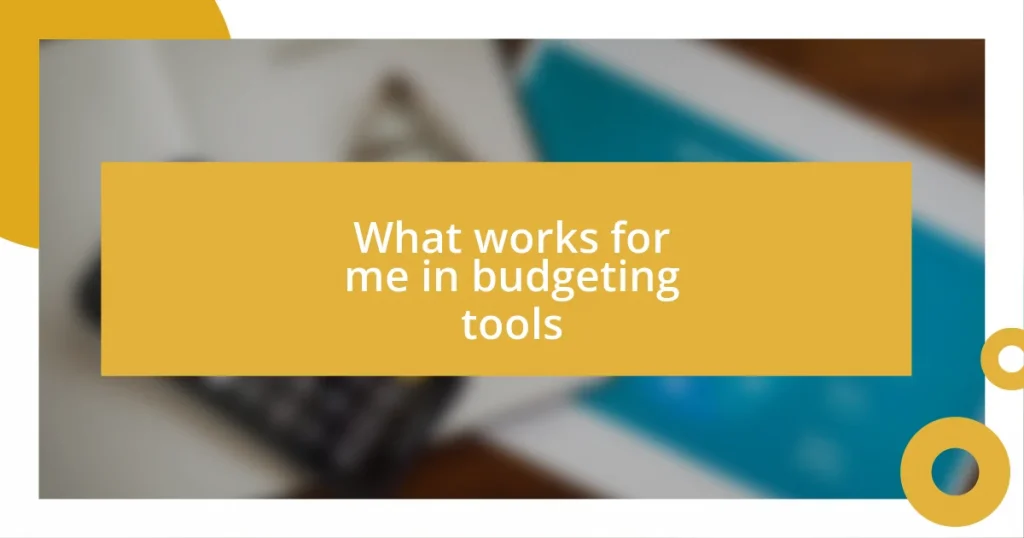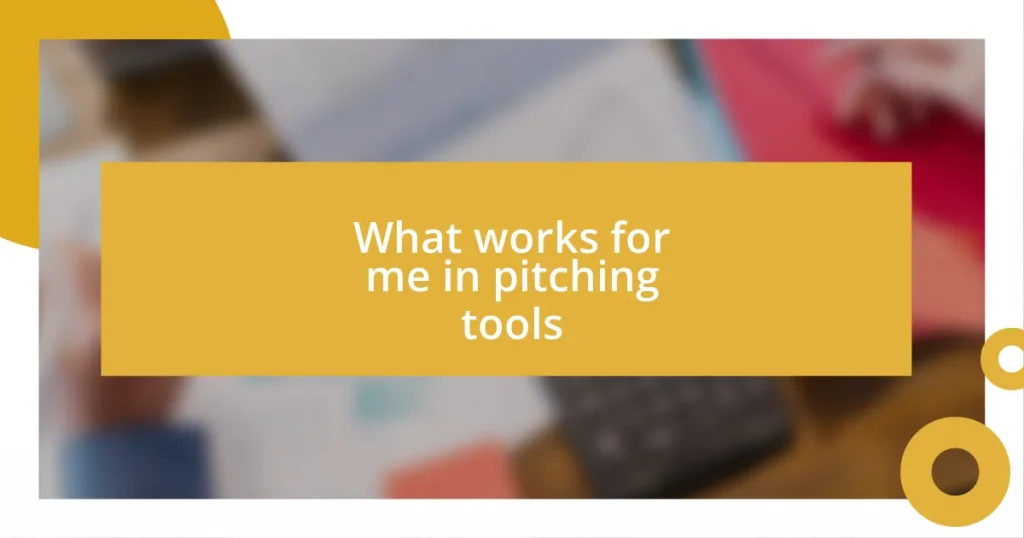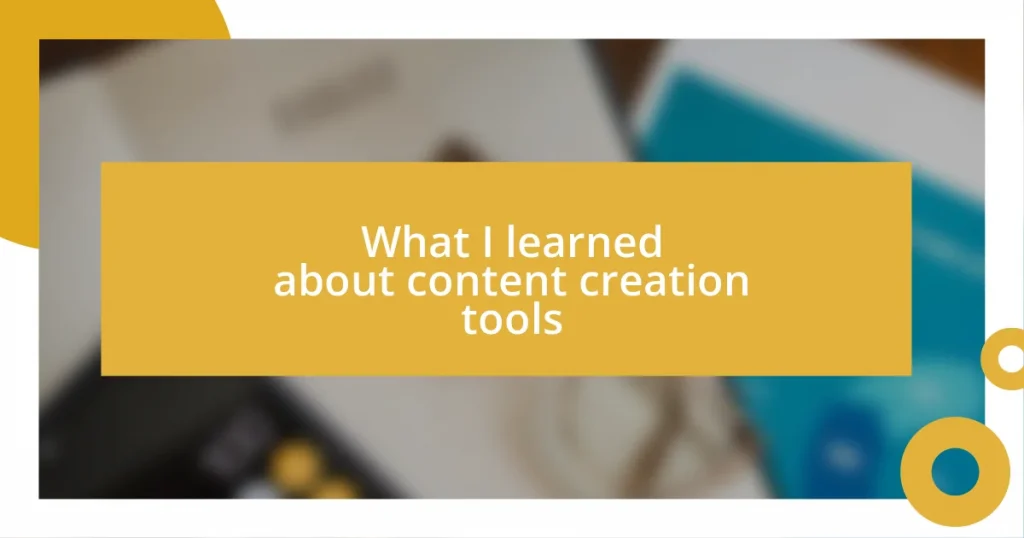Key takeaways:
- Identifying specific funding needs and goals is crucial; it clarifies the alignment between project scope and potential funding opportunities.
- Thoroughly researching available government programs and evaluating their eligibility requirements can streamline the application process and reduce the risk of oversights.
- Effective storytelling and clear reporting of outcomes foster strong relationships with funders, showcasing both successes and challenges transparently.

Understanding government funding options
Understanding government funding options can be quite the journey. When I first dove into this realm, it felt overwhelming—like standing at the base of a massive mountain. I still remember the first time I scrolled through pages of grants and loans, heart racing with anticipation. It made me wonder, how do I even decide which option suits my project best?
Every funding option has its nuances. For instance, did you know that some grants are specifically tailored for certain demographics or sectors? I discovered this when I stumbled upon a program aimed at small businesses in my community, which not only provided financial relief but also offered mentorship. It was enlightening to realize that government funding isn’t a one-size-fits-all solution; it requires some digging and aligning with your specific needs.
Finding the right government funding option can feel like searching for a needle in a haystack, but I’ve learned that patience pays off. I often think about my first successful application and how it transformed my perspective—it wasn’t just about the money; it represented validation and support for my ideas. Have you ever felt that sweet blend of excitement and fear when pursuing something you’re passionate about? That’s what makes navigating this funding landscape so impactful.

Identifying funding needs and goals
When identifying your funding needs and goals, it’s essential to first take a step back and assess what you truly require. I remember sitting down with a notebook, jotting down everything from potential project costs to the desired outcomes I envisioned. It struck me how crucial it was to align my funding requests with both the scale of my project and its impact on my community.
- Determine the specific purpose of the funding: Is it for a new initiative, expansion, or operational costs?
- Assess the scale of your project: Understand what budget range fits your vision.
- Reflect on the desired outcomes: What impacts do you hope to achieve, and how can funding help facilitate that?
- Consider the timeline: Are you looking for short-term relief or long-term partnerships?
Through this reflective process, I found clarity and confidence. Once I had my needs outlined, crafting my funding proposal felt less daunting and much more focused. It was almost like drawing a roadmap—I could visualize where I wanted to go and how each funding option could help me get there.

Researching available government programs
Researching available government programs can be both thrilling and challenging. I recall the hours spent digging through official websites, understanding which agencies offered funding that aligned with my goals. It’s essential to use multiple sources like government databases, local chamber of commerce websites, and community bulletin boards, as they often have updated information on programs that may not be widely advertised.
One strategy that worked wonders for me was making a spreadsheet to compare different programs. I listed their eligibility requirements, funding limits, and application deadlines side by side. This method turned the daunting task of scanning endless pages into a more manageable visual format. Plus, when I finally found a program I qualified for, it felt like a significant breakthrough, reaffirming my efforts.
There are various types of government funding options. You might encounter grants, which don’t require repayment, and loans that do. Some programs focus on specific sectors, like green energy or technology, while others are aimed at supporting local businesses. I always kept an open mind about what’s available, as I was surprised to discover many options tailored specifically to my industry.
| Funding Type | Repayment Required? |
|---|---|
| Grants | No |
| Loans | Yes |
| Subsidies | No |

Evaluating eligibility and requirements
Evaluating eligibility and requirements is a critical step in the funding process that I learned can often feel overwhelming. One thing I did was carefully read each program’s eligibility criteria. It was fascinating to discover that even the smallest details could make a difference. For instance, some grants required my project to benefit a specific demographic. Taking the time to scrutinize these requirements helped me avoid potential pitfalls, ensuring that my applications were both comprehensive and suitable.
In one instance, I almost overlooked an eligibility requirement related to project duration. It was a last-minute check that saved me a lot of heartache. I realized how easy it could be to assume I qualified based on other criteria. Have you ever felt that rush of panic when you discover a missed detail? I learned to double-check everything—sometimes, it’s the fine print that holds the key to success.
Additionally, I found it incredibly beneficial to reach out directly to program administrators. Engaging in dialogue not only clarified any uncertainties but also allowed me to gauge if my project was a good fit. More importantly, those conversations often provided insights that weren’t readily available in written documents. This back-and-forth makes the process feel much more approachable and can transform a daunting application into a collaborative effort. In my experience, having a conversation added a personal touch that made me feel more connected to the potential funders.

Preparing a compelling funding proposal
When I first set out to prepare a compelling funding proposal, I realized that clarity is key. I meticulously crafted my proposal’s narrative to clearly articulate the project’s impact and unique value. It’s like telling a story—one that resonates with the funder’s mission. I remember feeling a sense of accomplishment when I managed to weave in compelling statistics that highlighted the need for my initiative, allowing my passion to shine through while grounding my proposal in solid data.
An important lesson I learned was to tailor my proposal for each specific funding opportunity. While it might be tempting to use a one-size-fits-all approach, I found that addressing the unique goals of each program made a significant difference. After all, who doesn’t appreciate when someone shows genuine interest in what they’re offering? I often imagined myself in the funder’s shoes, asking: What do they want to achieve? By aligning my objectives with theirs, I created proposals that felt relevant and engaging.
Lastly, visual elements played a surprisingly impactful role in my presentations. Incorporating charts and images not only made my proposal more appealing but also helped clarify complex information. It was enlightening when I witnessed the shift in energy during my pitch—suddenly, the audience appeared more engaged. Have you ever seen someone’s eyes light up at a simple graph? Those moments reinforced my belief that a well-structured proposal, complete with visuals, can transform a good idea into an irresistible one.

Navigating the application process
Navigating the application process required a careful blend of meticulousness and flexibility. I vividly remember sitting at my desk with a mountain of paperwork, feeling both anxious and excited. The key was to approach each application as a unique puzzle; deciphering what each funder was really asking for. Have you ever felt overwhelmed by forms and guidelines? I certainly have, but I learned to break them down into manageable chunks, focusing on one requirement at a time to keep from getting lost in the nitty-gritty.
One strategy that worked wonders for me was maintaining a checklist throughout the process. By organizing documents and deadlines, I felt a sense of control amidst the chaos. It’s funny how something as simple as ticking off items can bring a wave of relief, right? I found that this not only helped streamline my applications but also gave me the confidence to stay on track and present my best self. I often found myself reflecting on how the little wins—from gathering documents to submitting on time—built my momentum.
Finally, I cannot emphasize enough the importance of storytelling throughout the application. I learned that funders are ultimately human too; they connect with narratives. When I shared personal anecdotes about my journey and the challenges faced, I felt an immediate shift in energy. It’s invigorating to think that by opening up about my experiences, I could evoke empathy and understanding from review panels. Have you ever had an experience that left you feeling vulnerable yet empowered? That’s the magic of narrative; it allows your passion to compel attention, making your application memorable rather than just another set of numbers on paper.

Managing funds and reporting outcomes
Managing funds effectively is one of the most critical aspects of any project. I recall a time when I had to juggle multiple funding streams for a community initiative. It felt like a balancing act—ensuring each dollar was allocated correctly while maintaining meticulous records. Using a simple spreadsheet became my lifeline; it felt empowering to have a clear overview of expenditures. If you’ve ever managed a budget, you know that staying organized prevents unnecessary stress and keeps the focus on the project’s goals.
Reporting outcomes can feel daunting, but I’ve come to see it as an opportunity to showcase success. After completing a funder-mandated report, I felt a rush of pride as I highlighted both quantitative metrics and personal stories from the participants. Isn’t it fulfilling to see numbers translate into real-life impact? What I found rewarding was that these reports often became touchpoints for future funding conversations. When funders could visualize the difference their investment made, it opened doors to further support.
Ultimately, I realized that transparency is crucial in managing funds and reporting outcomes. I aimed for honesty about setbacks, too, as they provide insight into a realistic context. Reflecting on my journey, I remember sharing a few challenges faced during the project alongside our successes in a progress meeting; it not only fostered trust but built stronger relationships with my funders. Have you ever noticed how vulnerability can pave the way for deeper connections? This taught me that straightforward communication nurtures collaboration and leads to better outcomes in the long run.















